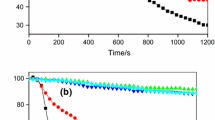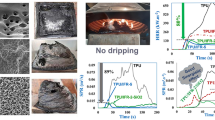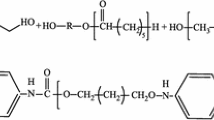Abstract
The flammability and droplet properties of thermoplastic polyurethane (TPU) have limited its wide application in many fields. In this article, isopropyl tris(dioctylphosphoryloxy) titanate was selected as synergism and compatilizer with oyster shell powder as flame retardant in TPU composites. And the influence of isopropyl tris(dioctylphosphoryloxy) titanate for flame-retardant TPU composites has been intensively investigated using the smoke density test, the cone calorimeter test, and the thermogravimetric analysis/infrared spectrometry, respectively. The test results show that isopropyl tris(dioctylphosphoryloxy) titanate can reduce the smoke production and heat release. And the total smoke production was reduced by 32% when the mass fraction of isopropyl tris(dioctylphosphoryloxy) titanate was 0.1%. The above results indicate that isopropyl tris(dioctylphosphoryloxy) titanate has a good application prospect in reducing the risk of TPU combustion.














Similar content being viewed by others
References
Zhang Q, Cai H, Yang K, Yi W. Effect of biochar on mechanical and flame retardant properties of wood – Plastic Composites. Results Phys. 2017;7:2391–5.
Lambertz A, van den Hil LCL, Schöb DS, Binnebösel M, Kroh A, Klinge U, et al. Analysis of adhesion formation of a new elastic thermoplastic polyurethane (TPU) mesh in comparison to polypropylene (PP) meshes in IPOM position. J Mech Behav Biomed Mater. 2016;53:366–72.
Zhang J, Kong Q, Yang L, et al. Few layered Co(OH)2 ultrathin nanosheets based polyurethane nanocomposites with reduced fire hazard: from eco-friendly flame retardance to sustainable recycling. Green Chem. 2016;18(10):3066–74.
Li H, Ning N, Zhang L, Wang Y, Liang W, Tian M. Different flame retardancy effects and mechanisms of aluminium phosphinate in PPO, TPU and PP. Polym Degrad Stab. 2014;105:86–95.
Hiremath P, Arunkumar HS, Shettar M. Investigation on effect of aluminium hydroxide on mechanical and fire retardant properties of GFRP-hybrid composites. Mater Today Proc. 2017;4(10):10952–6.
Wang Y, Wang F, Dong Q, Xie M, Liu P, Ding Y, et al. Core-shell expandable graphite @ aluminum hydroxide as a flame-retardant for rigid polyurethane foams. Polym Degrad Stab. 2017;146:267–76.
Wang M, Zeng X-F, Chen J-Y, Wang J-X, Zhang L-L, Chen J-F. Magnesium hydroxide nanodispersion for polypropylene nanocomposites with high transparency and excellent fire-retardant properties. Polym Degrad Stab. 2017;146:327–33.
Lu C, Gao X, Yao D, Cao C, Luo Y. Improving flame retardancy of linear low-density polyethylene/nylon 6 blends via controlling localization of clay and intumescent flame-retardant. Polym Degrad Stab. 2018;153:75–87.
Kim D, Lee J, Lee S, Lim J. Surface modification of calcium carbonate nanoparticles by fluorosurfactant. Colloids Surf A. 2018;536:213–23.
Narasimharao K, Ali TT, Bawaked S, Basahel S. Effect of Si precursor on structural and catalytic properties of nanosize magnesium silicates. Appl Catal A. 2014;488:208–18.
Jung S, Heo NS, Kim EJ, Oh SY, Lee HU, Kim IT, et al. Feasibility test of waste oyster shell powder for water treatment. Process Saf Environ Prot. 2016;102:129–39.
Elshereksi NW, Ghazali MJ, Muchtar A, Azhari CH. Studies on the effects of titanate and silane coupling agents on the performance of poly(methyl methacrylate)/barium titanate denture base nanocomposites. J Dent. 2017;56:121–32.
Peng C, Chen P, You Z, Lv S, Zhang R, Xu F, et al. Effect of silane coupling agent on improving the adhesive properties between asphalt binder and aggregates. Constr Build Mater. 2018;169:591–600.
Lu Y, Li X, Wu C, Xu S. Comparison between polyether titanate and commercial coupling agents on the properties of calcium sulfate whisker/poly(vinyl chloride) composites. J Alloys Compd. 2018;750:197–205.
Xu Q, Chen L, Harries KA, Zhang F, Liu Q, Feng J. Combustion and charring properties of five common constructional wood species from cone calorimeter tests. Constr Build Mater. 2015;96:416–27.
Chen X, Zhuo J, Jiao C. Thermal degradation characteristics of flame retardant polylactide using TG–IR. Polym Degrad Stab. 2012;97(11):2143–7.
Qian C, Fan XJ, Fan JJ, Yuan CA, Zhang GQ. An accelerated test method of luminous flux depreciation for LED luminaires and lamps. Reliab Eng Syst Saf. 2016;147:84–92.
Gye HJ, Nishizawa T. Reducing background optical density in enzyme-linked immunosorbent assay for detecting nervous necrosis virus (NNV)-specific IgM by immobilizing fish sera. Aquaculture. 2018;485:93–100.
Kong Q, Wu T, Zhang J, Wang D-Y. Simultaneously improving flame retardancy and dynamic mechanical properties of epoxy resin nanocomposites through layered copper phenylphosphate. Compos Sci Technol. 2018;154:136–44.
Kong Q, Wu T, Zhang H, Zhang Y, Zhang M, Si T, et al. Improving flame retardancy of IFR/PP composites through the synergistic effect of organic montmorillonite intercalation cobalt hydroxides modified by acidified chitosan. Appl Clay Sci. 2017;146:230–7.
Haixiang C, Naian L, Weitao Z. Critical study on the identification of reaction mechanism by the shape of TG/DTG curves. Solid State Sci. 2010;12(4):455–60.
Chaudhary RG, Juneja HD, Pagadala R, Gandhare NV, Gharpure MP. Synthesis, characterisation and thermal degradation behaviour of some coordination polymers by using TG–DTG and DTA techniques. J Saudi Chem Soc. 2015;19(4):442–53.
Mittleman M. Quantitative TG/IR. Thermochim Acta. 1990;166:301–8.
Acknowledgements
The authors gratefully acknowledge the National Natural Science Foundation of China (Nos. 51776101, 51206084), the Major Special Projects of Science and Technology from Shandong Province (2015ZDZX11011), the Natural Science Foundation of Shandong Province (ZR2017MB016), and the Project of the State Administration of Work Safety (shandong-0039-2017AQ).
Author information
Authors and Affiliations
Corresponding author
Additional information
Publisher's Note
Springer Nature remains neutral with regard to jurisdictional claims in published maps and institutional affiliations.
Rights and permissions
About this article
Cite this article
Chen, X., Zhang, X., Zhang, X. et al. Influence of isopropyl tris(dioctylphosphoryloxy) titanate for flame-retardant TPU based on oyster shell powder. J Therm Anal Calorim 139, 197–206 (2020). https://doi.org/10.1007/s10973-019-08299-1
Received:
Accepted:
Published:
Issue Date:
DOI: https://doi.org/10.1007/s10973-019-08299-1




